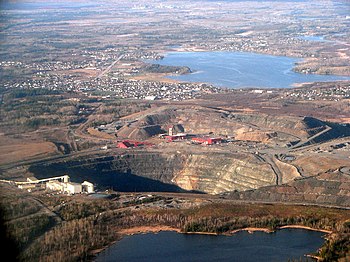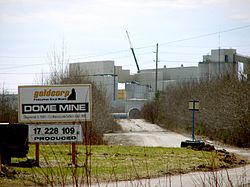Faymar Gold Mine Property -
Through its amalgamation with Faymar, Goldstone owns a 100%
interest in 26 patented claims, totaling 399 hectares
(985.5 acres) in Deloro Township near -
The Dome Gold Mine in Timmins.

http://en.wikipedia.org/wiki/Dome_Mine
A 1% net smelter return royalty is payable to the vendors
of the property.
The patents contain the past producing
Faymar Gold Mine
which produced 119,181 tons at an average recovered grade
of 0.183 ounces of gold per ton
and 0.11 ounces of silver per ton
between 1940 and 1942.
A total of 44,028 tons were also processed in
the Faymar mill
from the nearby Fuller property at an average recovered
grade of 0.148 ounces of gold per ton.
The Faymar patents are located in the Porcupine gold camp
and are underlain by Archean supracrustal rocks of
the Abitibi Greenstone Belt.
On the property, they predominantly consist of andesite and
basalt flows of the Deloro Group with minor iron formation.
A large body of dunite ultramafic occurs in the northwest
corner of the property and east-striking quartz-feldspar
porphyry dykes intrude the volcanic rocks and dunite.
Several faults occur on the property and are splays from
the nearby Destor-Porcupine Fault, a large regional structure
important in localizing gold in the Timmins area.
Gold on the Faymar property is hosted in a series of quartz
veins and shears, marginal to porphyry dykes.
An old asbestos deposit is also located in the ultramafic rocks.
An airborne magnetic and electromagnetic survey flown over
the Timmins area in 1987 detected a series of linear magnetic
and electromagnetic anomalies on the Faymar patents and
no follow-up work has been carried out to test their potential.
Goldstone (Ontex) announced encouraging results on the 2002 exploration
program on the Faymar Property in Deloro Township.
A mapping program re-discovered 60-year old workings along a
NW trending, high-grade gold-quartz vein from which samples
returned values up to 56 g/t Au.
Goldstone, however, was primarily interested in examining
the untested PGE potential of the ultramafic rocks that lie
to the west of the Faymar Gold Mine.
Surface samples from the ultramafic rocks returned values
up to 0.5 g/t Pt Platinum + Pd Paladium and 0.6% Ni Nickel.
A follow-up 2,419m (13 hole) diamond drill program yielded
concentrations up to 0.96 g/t Pt+Pd over 1.6m and 0.7% Ni.

http://www.grcmines.com/faymar.php
The Dome Gold Mine

Was the first producing gold mine in Timmins.
In the spring of 1909, a prospecting team led by Harry Preston
and Jack Wilson uncovered a mound or dome of golden crusted
quartz.
They staked their claims and called it “The Big Dome”.
The mine started as an underground operation and expanded
to include the super pit. It consists of many buildings
including the head frame (building with the red top),
mill, shops, and office building.
To date, it has produced over 15 million ounces of gold.
Not only was it one of the first mines to be discovered,
but it is Canada’s longest running gold mine.
Pamour Mine/Porcupine Joint Venture
Its ore body was first staked in 1909 by a prospector named
A.C. Brown, but for a variety of reasons, such as
the Great Fire of July 11, 1911, World War I, and
the stock market crash of 1929, along with a general lack
of funds, the mine had a difficult start-up.
In 1935, a deal was made between Noranda Mines Ltd. and
Pamour Porcupine Mines Ltd. to bring the mine into production
with Quebec Gold as the manager.
The name Pamour comes from a combination of the names of
two prospectors, Firman La Palme, and Wilfrid D’Amour who
were connected to the property at various times.
The Porcupine Joint Venture,
a joint development project by
Placer Dome Ltd. and Kinross Gold Corp
saw the Pamour pit
back in operation in 2005.
The relocation of Highway 101 allowed for the expansion of
the super pit and rerouted traffic to the south side of
Three Nations Lake.
Reserves are estimated at 1.8 million ounces of gold.
Porcupine Gold Mines Camp -
- 100th Anniversary Video -
The Porcupine Camp is dotted with head frames
and open pit mines;
some old, some newer, evidence of our mining heritage.
Historically, the district has been a major producer
of both gold and base metals.
Timmins Porcupine Gold -
Along the Porcupine-Destor Fault, which runs 200km from Timmins
to Destor in Quebec, over 65 million ounces of gold
have been mined.
Head frames towering majestically in our city’s skyline
conjure up images of adventure and heroism.
As picturesque as they are, their presence served a
necessary, practical function for past miners.
Through its amalgamation with Faymar, Goldstone owns a 100%
interest in 26 patented claims, totaling 399 hectares
(985.5 acres) in Deloro Township near -
The Dome Gold Mine in Timmins.

http://en.wikipedia.org/wiki/Dome_Mine
A 1% net smelter return royalty is payable to the vendors
of the property.
The patents contain the past producing
Faymar Gold Mine
which produced 119,181 tons at an average recovered grade
of 0.183 ounces of gold per ton
and 0.11 ounces of silver per ton
between 1940 and 1942.
A total of 44,028 tons were also processed in
the Faymar mill
from the nearby Fuller property at an average recovered
grade of 0.148 ounces of gold per ton.
The Faymar patents are located in the Porcupine gold camp
and are underlain by Archean supracrustal rocks of
the Abitibi Greenstone Belt.
On the property, they predominantly consist of andesite and
basalt flows of the Deloro Group with minor iron formation.
A large body of dunite ultramafic occurs in the northwest
corner of the property and east-striking quartz-feldspar
porphyry dykes intrude the volcanic rocks and dunite.
Several faults occur on the property and are splays from
the nearby Destor-Porcupine Fault, a large regional structure
important in localizing gold in the Timmins area.
Gold on the Faymar property is hosted in a series of quartz
veins and shears, marginal to porphyry dykes.
An old asbestos deposit is also located in the ultramafic rocks.
An airborne magnetic and electromagnetic survey flown over
the Timmins area in 1987 detected a series of linear magnetic
and electromagnetic anomalies on the Faymar patents and
no follow-up work has been carried out to test their potential.
Goldstone (Ontex) announced encouraging results on the 2002 exploration
program on the Faymar Property in Deloro Township.
A mapping program re-discovered 60-year old workings along a
NW trending, high-grade gold-quartz vein from which samples
returned values up to 56 g/t Au.
Goldstone, however, was primarily interested in examining
the untested PGE potential of the ultramafic rocks that lie
to the west of the Faymar Gold Mine.
Surface samples from the ultramafic rocks returned values
up to 0.5 g/t Pt Platinum + Pd Paladium and 0.6% Ni Nickel.
A follow-up 2,419m (13 hole) diamond drill program yielded
concentrations up to 0.96 g/t Pt+Pd over 1.6m and 0.7% Ni.

http://www.grcmines.com/faymar.php
The Dome Gold Mine

Was the first producing gold mine in Timmins.
In the spring of 1909, a prospecting team led by Harry Preston
and Jack Wilson uncovered a mound or dome of golden crusted
quartz.
They staked their claims and called it “The Big Dome”.
The mine started as an underground operation and expanded
to include the super pit. It consists of many buildings
including the head frame (building with the red top),
mill, shops, and office building.
To date, it has produced over 15 million ounces of gold.
Not only was it one of the first mines to be discovered,
but it is Canada’s longest running gold mine.
Pamour Mine/Porcupine Joint Venture
Its ore body was first staked in 1909 by a prospector named
A.C. Brown, but for a variety of reasons, such as
the Great Fire of July 11, 1911, World War I, and
the stock market crash of 1929, along with a general lack
of funds, the mine had a difficult start-up.
In 1935, a deal was made between Noranda Mines Ltd. and
Pamour Porcupine Mines Ltd. to bring the mine into production
with Quebec Gold as the manager.
The name Pamour comes from a combination of the names of
two prospectors, Firman La Palme, and Wilfrid D’Amour who
were connected to the property at various times.
The Porcupine Joint Venture,
a joint development project by
Placer Dome Ltd. and Kinross Gold Corp
saw the Pamour pit
back in operation in 2005.
The relocation of Highway 101 allowed for the expansion of
the super pit and rerouted traffic to the south side of
Three Nations Lake.
Reserves are estimated at 1.8 million ounces of gold.
Porcupine Gold Mines Camp -
- 100th Anniversary Video -
The Porcupine Camp is dotted with head frames
and open pit mines;
some old, some newer, evidence of our mining heritage.
Historically, the district has been a major producer
of both gold and base metals.
Timmins Porcupine Gold -
Along the Porcupine-Destor Fault, which runs 200km from Timmins
to Destor in Quebec, over 65 million ounces of gold
have been mined.
Head frames towering majestically in our city’s skyline
conjure up images of adventure and heroism.
As picturesque as they are, their presence served a
necessary, practical function for past miners.
Join the InvestorsHub Community
Register for free to join our community of investors and share your ideas. You will also get access to streaming quotes, interactive charts, trades, portfolio, live options flow and more tools.










